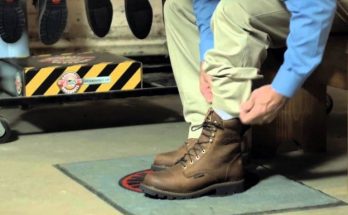Any electrician’s safety is of the highest significance. Aside from maintaining tools properly, wearing appropriate clothes, and strictly following a code of conduct, it is also critical to utilize the Best non-conductive FiberGlass ladders for electrical work.
In today’s post, I’ve not only shared with you my advice on selecting the correct electrical ladder but also our best picks for the market right now.
Best FiberGlass Ladders for Electrical Work
| Image | Product |
|---|---|

|
The Runner-up: Louisville Ladder FS1523 FS1512 Fiberglass Ladder Editor's Rating: 9.9 Brand: Louisville Ladder Check Price |

|
Best Safety: Little Giant Ladders 15422-001 Editor's Rating: 9.7 Brand: Little Giant Ladder Systems Check Price |

|
Best Overall: HBTower 3 Step Ladder Editor's Rating: 9.5 Brand: HBTower Check Price |

|
Best Budget: Lion Ladder 3 Step Ladder Editor's Rating: 9.3 Brand: xaestival Check Price |

|
Best Value: Delxo Folding 4 Step Ladder Editor's Rating: 9 Brand: Delxo Check Price |
Top 5 best ladders for electricians
Ladder Safety for Electrical Work
Ladder safety should be followed when working with electricity, an electrical circuit, or equipment. Ladders come in a variety of shapes and sizes, and they are manufactured from a variety of materials. When working with electricity, metal ladders should never be utilized. Always use a non-conductive wood or fiberglass ladder.
1. Ladder Safety Basics
Step ladders are frequently used for both indoor and outdoor electrical hookups. Step ladders cannot reach the heights that extension ladders can. Before ascending any ladder, certain fundamental ladder safety precautions should be followed.
It is critical to have level and solid flooring, as well as sturdy ladders with locking safety arms. A safe work environment includes barriers above and a clear, debris-free space below and around the ladder base.
2. Lock the ladder
Before mounting the stairs, always completely open the ladder and lock the locking arms into position. This is true for both step and extension ladders. Step ladders have two locking arms, one on each side, that allow each ladder leg side to firmly lock into place, preventing the ladder legs from closing back up.
Extension ladders are divided into two parts. The feet are on the bottom portion, while the top section includes plastic end caps or wings to attach to the side of a building or pole.
The top part also includes two spring-loaded locking arms that link to the bottom segment’s legs. As you climb, these arms prevent the top part from falling back down.
3. Level and Solid Ground for the Ladder Base
Before attempting to ascend a ladder, place it on level working surfaces or level the space. This should be a firm surface. If you’re going to add soil or gravel to level the surface, make sure it’s well-compacted and firm.
Sometimes the circumstance necessitates the use of blocking material to level the ladder’s base. Instead of sticks or other materials that may easily slip from the bottom of the ladder base, choose flat, sturdy planks or timbering.
4. Knowing the climbing limits
Never climb to the top of the next-to-last step of a ladder. Never place yourself in a situation where you have to strain to get to what you’re working on. To perform the work safely, get a taller ladder.
Working with power tools might increase the risks of standing on the top of a ladder. You might tumble off the ladder if a drill bit sticks and jerks you about. Ladders become unstable when your entire weight is on top of them, forcing the top to move and your feet to push the top of the ladder in one way. This sends you plummeting to the ground.
5. Before climbing a ladder, look around for hidden hazards
Be wary of concealed hazards such as exposed wires and obstructions that you may run into when ascending the ladder. Electrical wires, such as overhead service lines, are frequently present in the area where you are operating.
Not only that, there may be pipes or other objects protruding from the ground that might injure you if you fall from a ladder onto them. If at all possible, get these hazards out of the way before you begin.
6. Foot the Ladder
If at all feasible, have a helper hold the ladder for support. When someone is climbing up for the first time, having someone foot the ladder and keep it from sliding is always a benefit in terms of safety. That way, the ladder will be sturdy for them to climb up and tie off. Also, remember to keep the ladder steady for the final person to leave the roof. This allows him to securely untie the ladder and leave.
7. Tie-Off Ladders for Safety
If feasible, tie off the top of an extension ladder. This prevents the ladder from slipping off the edge of the wall or roof. Nothing is scarier than falling off the roof onto an unsecured ladder and riding it to the ground with a loud thud!
Simply attach a nail or screw beneath a single or tie off to a sturdy structure on or near a roof, such as an antenna or bracket. If you’re climbing onto another surface, make sure the ladder reaches at least three feet beyond the platform you’re going onto.
8. Standing on a Ladder Precautions
Climbing and standing on a ladder may appear straightforward, but these guidelines should be followed to protect your safety.
- When ascending or descending, keep your back to the ladder.
- Always keep both feet on the ladder; never place one foot on a rung and the other on another surface.
- Climb no higher than the second step ladder rung or the third rung of a straight or extension ladder.
- Never stand on the top of a stepladder’s paint shelf.
9. Use Proper Ladder Angles
Make sure that the angle of an extension ladder is not too steep or that it is not too far away from the work area. For ladder safety, adhere to the appropriate angle guides on the ladder. To guarantee a steady working platform, use the 1:4 ratio. Place the ladder’s base 1 foot away from whatever it is leaning against for every 4 feet of height to the point where the ladder meets the ceiling at the top.
Too much angle puts strain on the center of the ladder, causing the bottom legs to thrust outward away from the structure you’re working on. The lack of sufficient angle on the ladder leads the ladder to be off-center. It seems like you’re falling backward as you rise. Gravity may drag you and the ladder off the roof once you reach the summit.
Buying Guides
1. Buy the ladder suitable for your electrician work
Select the appropriate design and height for the task you conduct. And, as always, test before you purchase. Climb three steps using stepladders and gently shift your weight. The ladder should not be bent, tilted, or walked. Check out a multipurpose model in the shop to see how simple it is to adjust and lock – and ask if you can return it if it proves more difficult than you anticipated.
2. Safety Concern
According to the American Ladder Institute, the industry’s primary trade association, ladder injuries are usually caused by abuse and poor selection. However, based on some of the research, poor design and construction may contribute considerably to such injuries.
3. Size
Choose a ladder that is tall enough for the work and does not force you to reach up in a way that would destabilize the ladder. Stepping above a ladder’s declared maximum height does, in fact, greatly increase the chances of an accident. An extension ladder should be at least three feet above the roof or work surface.
4. Materials
Aluminum ladders are the lightest, but they carry electricity and should never be used near power lines or other high-voltage sources; instead, use a fiberglass or wooden ladder. Also, keep in mind that any ladder, regardless of material, can conduct electricity when wet.
FAQ
1. Is it necessary for electricians to use ladders?
When an electrician has to work in a high area, he must use a ladder to get there. When selecting a ladder, the electrician should prioritize a non-conductive ladder (fiberglass or hardwood). The non-conductive ladder aids in the avoidance of electrical dangers.
2. What is the purpose of using wooden ladders by electricians?
A hardwood ladder, like fiberglass material, is a non-conductive ladder. As a result, it is excellent for use in any electrical project. However, if this ladder is exposed to dampness, it may deteriorate. Furthermore, the wooden ladder is difficult to use in damp weather.
3. Is it safe to use an aluminum ladder for electrical work in a wet area?
Although it depends, I recommend that you do not use it for electrical work in a moist environment. If you don’t have a choice, make sure the power is turned off to avoid electrocuting yourself. If you want a safe choice, you should go with a fiberglass ladder.
4. Is it true that aluminum ladders transmit electricity?
Aluminum is, indeed, a conductive substance. Even if the rubber feet aren’t safe, it’s difficult to prevent electrical dangers while utilizing this ladder for electrical work.
Conclusion
Finally, choosing the finest sort of ladder for an electrician is certainly not a difficult process. You must be aware of what is available and the features that have been implemented.
For novices, it is only logical to choose a simple ladder with enough sturdiness. You must ensure that the ladder is secure enough for the duties you will be performing.
And once that issue is overcome, selecting a certain ladder becomes quite straightforward. Just be sure you get something that is long-lasting, easy to use, and easy to clean.



